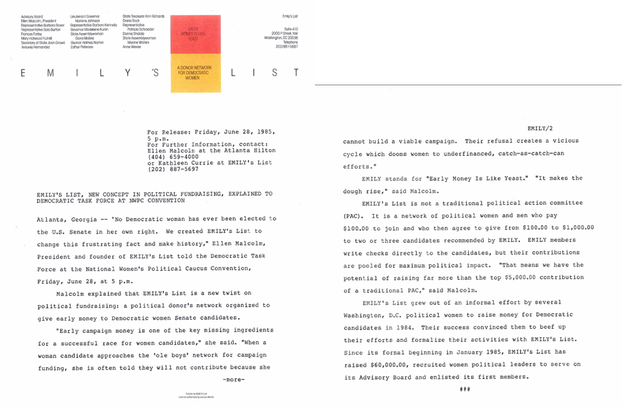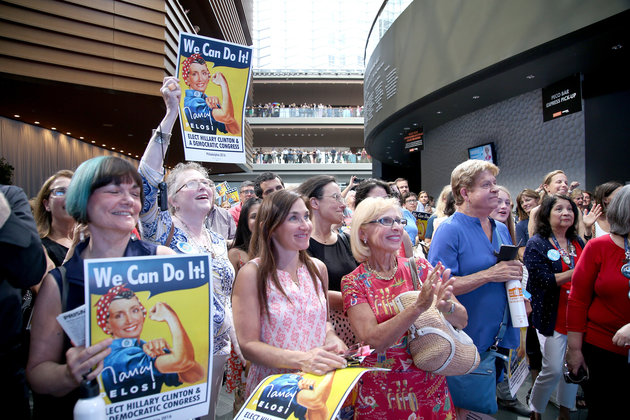PHILADELPHIA ― This is the night that Ellen Malcolm has been waiting for almost her whole life.
Malcolm, now 69, and a few friends got together in 1985 to figure out how to get more women into office. They saw a chance to harness the collective power of women, who weren’t big campaign contributors. The plan was to get money to female candidates early in their campaigns ― a way of convincing the old boys’ network that they could be viable and deserving of establishment support.
Today, EMILY’s List ― now run by Stephanie Schriock ― has more than 3 million members and has raised more than $400 million from over 81,000 people, making it one of the most successful political action committees. Since its founding, it’s elected 110 women to the House, 19 to the Senate, 11 to gubernatorial seats and more than 700 to state and local positions.
And on Thursday night, Hillary Clinton will take the stage and accept the Democratic nomination for president, making her the first woman in U.S. history to be at the top of a major party’s ticket.
“We’ve made history so many times, but the top ― the White House ― has always been very elusive,” Malcolm said in an interview with The Huffington Post. “You can’t really claim women have political equality until you show you can win the biggest race there is.”
While more than 200 women have pursued the presidency since 1872, the year Victoria Woodhull became the first woman to run for the highest office in the land, no one has come as close as Clinton.

That excitement was palpable Wednesday at a party for EMILY’s List supporters at the Kimmel Center for the Performing Arts, where hundreds turned out to toast the organization and the women it has helped elect.
Sen. Chuck Schumer (D-N.Y.), who is set to take over as head of the Democratic caucus next year after Senate Minority Leader Harry Reid (D-Nev.) retires, was the sole male speaker at the event and emphasized the importance of the group.
“I want to say this: There’s one word that’s key to us taking back the Senate and getting a majority. It begins with a ‘W’ ― Women!” Schumer exclaimed.
The event brought together the organization’s founders and its next generation. Lynn Yeakel challenged incumbent Sen. Arlen Specter (R-Pa.) in 1992, outraged at the way he went after Anita Hill during the Judiciary Committee hearings on Clarence Thomas’ Supreme Court nomination. The proceedings struck a chord with women around the country, who saw an all-male, all-white panel of senators dismiss the sexual harassment that Hill faced.
Yeakel lost, but four other Democratic women won that year and joined Barbara Mikulski (D-Md.) in the Senate. Yeakel still lives in Philadelphia and continues to work on promoting social, economic and political equality for women. She said this year’s convention was bringing back memories of 1992 ― dubbed the “Year of the Woman” because of the then-record number of women running for office. The female Senate candidates were prominent at the ‘92 convention, and all went onstage, introduced by Texas Gov. Ann Richards (D).
That year, EMILY’s List had another big event, “Faces of Change United States Senate,” or FOCUS, where more than 3,000 people turned up to help raise money for and celebrate the female candidates.
“I still have the T-shirt” from the event, Yeakel said.
“This year is really the year of the woman,” she added, “and I know there are more women running for the Senate than there even were that year, and so it’s just really exciting to see.”
With Yeakel was her 17-year-old granddaughter, Mae, who said she has thought about running for Senate herself someday.
“I’ve always been supportive of my grandmother,” Mae said. “She’s probably my biggest role model.”
Attendees at the event were often in awe when they stopped to think about how far the country has come in the last couple decades, in the lead-up to Clinton’s big Thursday night speech.
Terri Hamilton Brown, 54, from Cleveland, said she never thought she’d see a black president, let alone a black president and, potentially, a female president.
“So, I believe. I am a complete believer,” she said.
Katie McGinty, who is challenging Sen. Pat Toomey (R-Pa.) this cycle, is one of EMILY’s List’s top prospects this cycle and spoke at the event Wednesday. She said the organization was vital in first encouraging her to run and then providing resources and support. And while the environment today is no doubt better for women running for office than it was when EMILY’s List first started, there are still challenges.
“You’re sized up from a point of view of, ‘How do you look?’ maybe a little bit more than a male would be, as compared to, ‘What are your values?’ ‘What have you done?’ ‘What have you accomplished?” McGinty said.
“I have three children. You still run into, ‘Well, how are you possibly gonna do this to your children?’ Just questions male candidates don’t get asked,” added Rep. Katherine Clark (D-Mass.).
Malcolm, meanwhile, said she had great memories of the 1992 convention and FOCUS event. “But this is different,” she added. “This is looking at the fruits of my labor for 30 years, and feeling very proud.”- Publish my comments...
- 0 Comments
